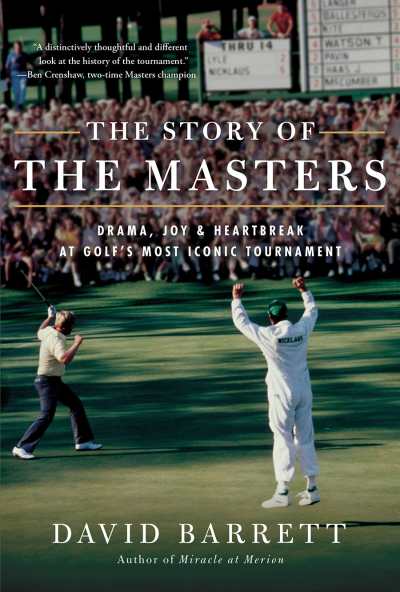Reviewer Jeff Fleischer Interviews David Barrett, Author of The Story of the Masters: Drama, Joy, and Heartbreak at Golf’s Most Iconic Tournament

A particularly sadistic sort of golf fan tunes into just a couple major tournaments a year because, frankly, they like to see cocky, pampered young millionaires have nervous breakdowns on television. Well, here we are—it’s Masters week and you can be confident that golf’s coterie of schadenfreuders will be watching the action.

In all of sports, it’s impossible to exaggerate the gut-wrenching magnitude of this tournament. For the world’s best golfers, after four grueling days, the ultimate test and nightmare is to face a five foot, downhill putt on the 18th green on Sunday to win or lose a Masters title. Watch their hands shake. Watch them nervously step back and study the putt again and again. Pity their terror because nothing comes close to the challenge and some players never recover from a miss, knowing they didn’t have the right stuff to keep their shit together. A putt they would easily make ten times in a row during a practice round will mar their professional legacy forever. Augusta National is where golf dreams go to die.
To explain why this sporting event is unlike any other, David Barrett stops by Foreword This Week to take a few questions from Jeff Fleischer—Jeff having penned the review of David’s delightful The Story of the Masters for Foreword’s March/April issue.
And should you find yourself in need of some sporting drama unlike any other, postpone your Sunday afternoon nap; you won’t be sorry.
What was the specific inspiration to write The Story of the Masters? What prompted the decision to approach the tournament year by year?
Year in and year out, the Masters provides more drama than any tournament. The design of the Augusta National course lends itself to the possibility of thrilling charges by a player who is on his game, yet with enough danger that it’s not uncommon to see players throw away shots and let a potential victory slip away. This leads to a volatile leaderboard and plenty of plot twists in the tournament action.
It’s a major championship, so the plot involves the leading characters in the game. The game’s greatest and most dynamic players—Jack Nicklaus, Tiger Woods, Arnold Palmer—have enjoyed more success at the Masters than any other tournament. While there have been other books about the Masters, they tend to focus on issues involving the Augusta National club or its longtime chairman Clifford Roberts. It seemed to be a hole in golf literature that there hasn’t been a comprehensive history of the action of the tournament itself. I decided to approach it year by year because each year has its own story. There are threads that run through the years, but I felt it best for the reader to be able to focus on one year at a time.
In researching the book, what did you learn about the tournament? What most surprised you?
I was surprised that the tournament telecast was blacked out within a 225-mile radius of Augusta from the first broadcast in 1956 all the way to the late 1960s. The blackout remained in effect even after the tournament became a sellout in the 1960s. Tournament officials were concerned that ticket sales would be diminished if people could watch the tournament on TV. That’s ironic, considering that the event was well on its way to becoming the hottest ticket in sports. The blackout was finally lifted in a couple of cities about 150 miles away in 1967 and 1968, and when ticket sales didn’t decline in those cities the blackout was lifted in 1969. By then, tickets were going to a list of previous ticket holders, and it was only four years later that the waiting list to get on that list was getting so long that it was closed.
Also on the subject of crowds, it is apparently an apocryphal story that Jack Whitaker was pulled as an announcer from the telecast in the late 1960s for calling the gallery on the 18th hole a “mob.” But in 1962, the Augusta Chronicle ran a photo showing a sea of humanity on the course with the headline “Mob Scene in 26th Masters Tournament.” The next year, ticket sales were limited for the first time to keep crowds at a manageable level.
If you had to pick a particular year as most emblematic of what makes the tournament special, which would it be and why?
I have to go with the consensus of 1986 as the greatest year of the Masters, and also perhaps the most emblematic. In Jack Nicklaus, you had a player showing his greatness and adding to his legacy. You had a large cast of characters with chances to win on Sunday, all of them moving up and down the leaderboard while hearing gallery roars from action all over the course. You had back-nine heroics, with Nicklaus shooting a 30 on that nine to win after trailing by six shots standing on the ninth green (where he birdied to start his charge). You had players blowing it, most notably Seve Ballesteros hitting into the pond on the 15th hole. You had Greg Norman going both ways, making a double bogey on the 10th but recovering with four straight birdies starting on the 14th. You had 72nd-hole drama, with Tom Kite barely missing a birdie putt to finish one behind and Norman coming to the hole tied but making a bogey.
Of the Masters tournaments you’ve personally covered, which was most memorable? Why?
Other than 1986, I’ll say Tiger Woods’ victory in 1997. The whole week was memorable, starting with the hype surrounding Woods coming in with three straight US Amateur titles and already starting his pro career in grand fashion heading into his first professional major championship. The fact that he shot 40 on his first nine holes makes his ultimate runaway victory even more remarkable. It was amazing watching him overpower the course and the field to a nine-stroke lead through 54 holes. That led to the memorable appearance by Colin Montgomerie in the media center Saturday, after being dusted by Woods, saying “there’s no way Tiger Woods doesn’t win tomorrow” and when it was pointed out that Greg Norman had blown a big lead the year before, responding, “[Nick] Faldo is not lying second, for a start, and Greg Norman is not Tiger Woods.” While the final round didn’t provide suspense, it had the feeling of watching history in the making, with the appropriate ending of a 72-hole scoring record.
In tracking the tournament through the years, what stood out most to you in terms of the biggest changes over time?
The rise of international players has been the most notable change over the years. At the start in the 1930s, nearly all of the players were American, in part due to the difficulty of international travel in those days. South Africa’s Gary Player was the first non-American winner (1961, 1964, 1978), and there was a sea change in the 1980s and 1990s with a wave of European champions (eleven Masters in those two decades won by Europeans). In 2020, essentially half the field (forty-five of ninety-two) were from outside the United States. The other thing to note is the changes made to the course over the years in an effort to maintain the challenge. The first big change was to slicker bentgrass greens in 1980 after scoring dipped considerably in the 1970s, and then lengthening the course (while also narrowing it with tree plantings and longer grass off the fairways) in the early 2000s when driving distance exploded on the PGA Tour.
What do you most hope the audience comes away with after reading the book?
I hope they were able to relive the experience of the Masters that they were able to watch, jogging their memory of the most significant events, embellished by nuggets that they have forgotten or were not even aware of at the time. And I hope they learned a lot about the years of the Masters they didn’t experience, particularly the early years. I hope that they come away with an appreciation of the greatest players in the history of golf, and the way they shined at the Masters, as well as for those who battled gamely but came up short.
Jeff Fleischer
